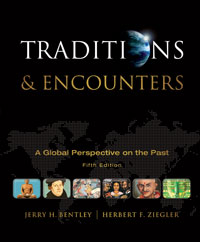1 A) Muslim African scholars. B) professional singers and griots . C) village chiefs and diviners. D) women. E) None of these answers is correct. 2 A) the heroic deeds of the lion prince in establishing the Mali empire. B) the misery of slaves captured and traded in the Mediterranean basin network. C) the coming of Islam as a dominant faith in sub-Saharan societies. D) the rise of the Swahili city-states. E) None of these answers is correct. 3 A) Africans had little contact with each other. B) Africans did not have any goods that others wanted to trade for. C) there was a language barrier. D) there were formidable geographic barriers to overcome. E) All these answers are correct. 4 A) aggressive warriors. B) hunting and gathering peoples. C) fishing peoples. D) agriculturalists. E) horsemen. 5 A) iron metallurgy. B) bubonic plague. C) bananas. D) population pressure. E) agriculture. 6 A) city-state. B) empire. C) kin-based system. D) kingdom. E) theocracy. 7 A) Male heads of families presided over village affairs. B) The most prominent of the family heads acted as chief. C) A group of villages constituted a district. D) Ethnic loyalties were focused at the district level. E) All these answers are correct. 8 A) emerged as a powerful state through trading with Muslim merchants of north Africa. B) maintained a royal currency system based on cowries from the Indian Ocean. C) was a loosely organized government with little authority over officials. D) was destroyed by the expansion of the Swahili. E) None of these answers is correct. 9 A) made communication across the Sahara possible. B) quickened the pace of communication across the Sahara. C) replaced elephants as the preferred transport animals throughout the Sahara. D) still did not make travel across the Sahara possible. E) None of these answers is correct. 10 A) Mansa Musa was to the Mali empire. B) Niani was to the Mali empire. C) Sundiata was to the Mali empire. D) Zaire was to the kingdom of Kongo. E) Axum was to the Christians. 11 A) stimulated commercial relations with Muslim merchants. B) meant that Islamic faith was imposed forcibly on their entire societies. C) facilitated the export of Muslim African slaves by these two states to other Islamic countries. D) transformed the role of women in those cultures. E) All these answers are correct. 12 A) was an Arabic language. B) refers to the peoples of the east African coast. C) refers to the slave traders of Africa. D) is a dead language. E) was the language of the Mali empire. 13 A) Sofala and Mogadishu. B) Zimbabwe and Ife. C) Malindi and Kilwa. D) Zanzibar and Mozambique. E) None of these answers is correct, because all were Swahili city-states. 14 A) a powerful guild of gold merchants. B) the king of an empire. C) an anti-Islamic organization of Zimbabwe. D) a capital city built of stone. E) None of these answers is correct. 15 A) had only hunters, gatherers, and fishers. B) was a large, inland, overland trade city. C) had not yet converted to Islam. D) was hostile to strangers. E) None of these answers is correct. 16 A) slaves did not exist. B) private ownership of land did not exist. C) gender differentiation did not exist. D) war did not exist. E) currency did not exist. 17 A) demand for slaves in foreign markets outstripped the supply. B) a population explosion created a ready surplus. C) slaves were needed on the other side of the Atlantic. D) Africans readily sold their children into slavery. E) All these answers are correct. 18 A) concern itself with morality and proper behavior. B) concern itself with matters of theology. C) concern itself with world order. D) worship a creator god. E) include religious specialists in society. 19 A) located in a much smaller region. B) equally important. C) more true to original Christian theology than African Islam was to original Islamic theology. D) had little to do with merchants or missionaries. E) None of these answers is correct. 20 A) were increasingly confined in their social and economic activities. B) did not experience much change in their social status. C) enjoyed higher honor than before. D) took the veil. E) could no longer talk to men in public.





